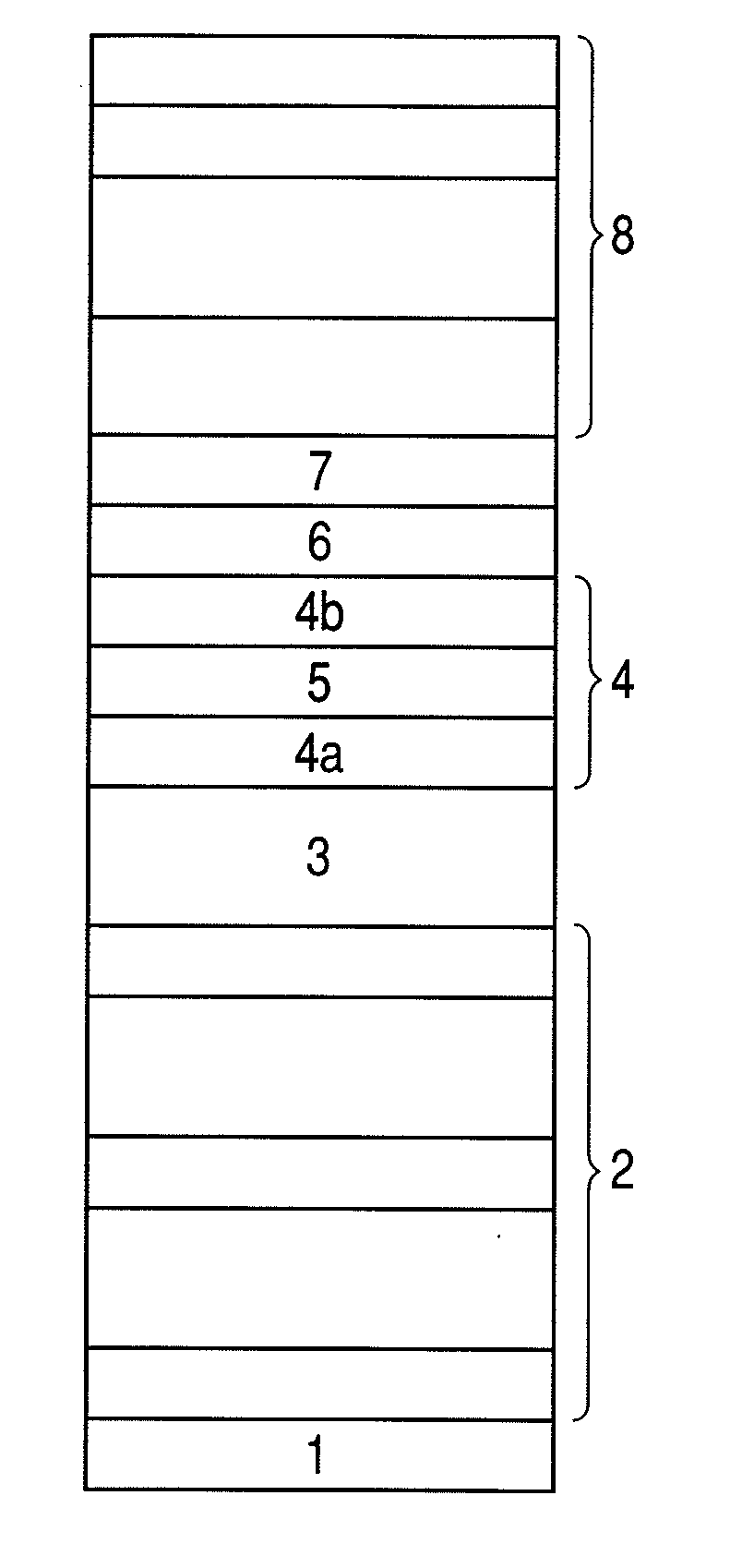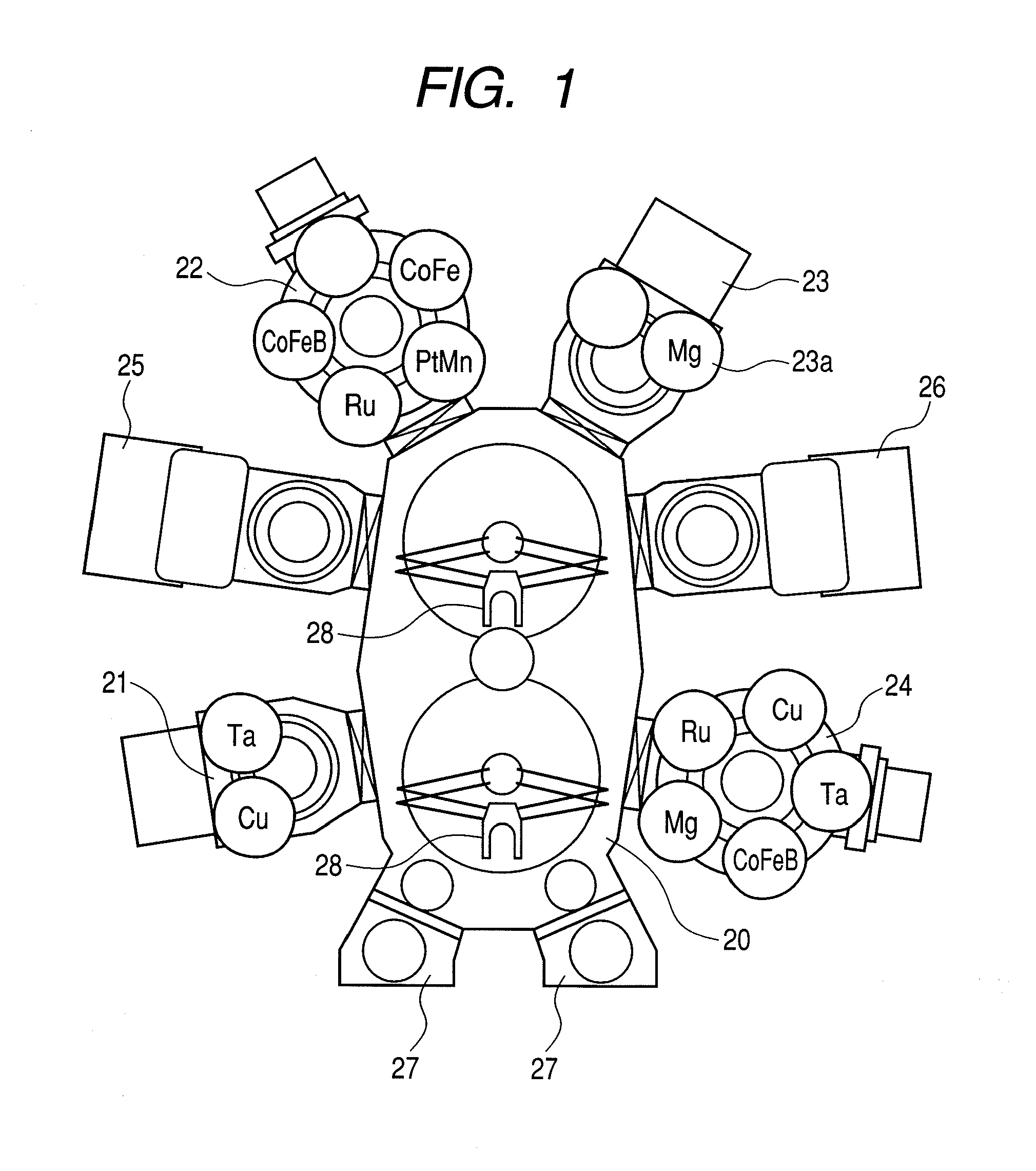Method of fabricating and apparatus of fabricating tunnel magnetic resistive element
a tunnel magnetic resistive element and fabrication method technology, applied in nanoinformatics, instruments, record information storage, etc., can solve the problems of remarkably reducing the throughput of production, affecting the yield factor at the time of device fabrication, and likely dispersion, so as to achieve low ra and high mr ratio
- Summary
- Abstract
- Description
- Claims
- Application Information
AI Technical Summary
Benefits of technology
Problems solved by technology
Method used
Image
Examples
example 1
[0055]FIG. 3 is a film configuration diagram of a tunnel magnetic resistive element produced with a fabrication method and a fabrication apparatus related to the present invention. IrMn with thickness of 7 nm is used as antiferromagnetic layer 3. A Ru layer of 5 nm is used as its underlying layer 9. Otherwise, the film configuration is the same as that of FIG. 2.
[0056]With reference to FIG. 4, a forming method of a tunnel barrier layer related to the present example will be described. FIG. 4 is a flow chart of film formation of a tunnel barrier layer according to the present example. In a step S401, film formation was carried out until a first ferromagnetic layer is formed as described in the above embodiment. In a step S403, on a CoFeB layer to become the first ferromagnetic layer, film formation of metal Mg of 1.2 nm was carried out in the atmosphere obtained by independently introducing Ar gas at 15 sccm and oxygen at 5 sccm (the mixed oxygen concentration is 25%). Subsequently, ...
example 2
[0060]FIG. 6 illustrates a flow chart for forming a tunnel barrier layer in the case of stopping mixture of oxygen gas in the initial period and at the end of film formation at the occasion of oxygen doping at the time of film formation of the first metal layer. At that time, radical oxidation was used as a method of oxidizing the first metal layer. The film configuration in FIG. 2 was adopted for the film configuration of the tunnel magnetic resistive element.
[0061]With reference to FIG. 6, the flow of forming the tunnel barrier layer will be described below. In a step S601, film formation of up to the first ferromagnetic layer was carried out as described in the above embodiment. In a step S603, through the following three steps, film formation of the first metal layer was carried out on the first ferromagnetic layer. That is, at the initial stage of film formation of the first metal layer, film formation of the first metal layer was carried out in the Ar gas atmosphere without in...
example 3
[0068]FIG. 9 is a graph illustrating distribution of RA inside the substrate surface at the occasion of radical oxidation only with an oxidation time of 100 seconds in a tunnel magnetic resistive element with the same film configuration as the tunnel magnetic resistive element obtained through the same method of forming the MgO tunnel barrier as those used for Example 2. The abscissa axis is for distance from the center of the wafer having a diameter of 300 mm. For the purpose of comparison, the graph also shows RA distribution of a tunnel magnetic resistive element with an MgO tunnel barrier having been formed by RF sputtering directly from an MgO sintering target. According hereto, the RA distribution of the tunnel magnetic resistive element formed by the method of the present invention is 1.6% being a result apparently better than the RA distribution of 9.4% of the method by RF sputtering on the MgO sintering target.
PUM
| Property | Measurement | Unit |
|---|---|---|
| pressure | aaaaa | aaaaa |
| thickness | aaaaa | aaaaa |
| thickness | aaaaa | aaaaa |
Abstract
Description
Claims
Application Information
 Login to View More
Login to View More - R&D
- Intellectual Property
- Life Sciences
- Materials
- Tech Scout
- Unparalleled Data Quality
- Higher Quality Content
- 60% Fewer Hallucinations
Browse by: Latest US Patents, China's latest patents, Technical Efficacy Thesaurus, Application Domain, Technology Topic, Popular Technical Reports.
© 2025 PatSnap. All rights reserved.Legal|Privacy policy|Modern Slavery Act Transparency Statement|Sitemap|About US| Contact US: help@patsnap.com



